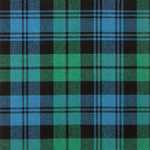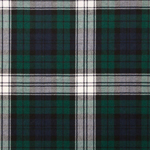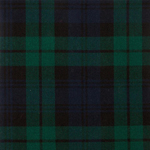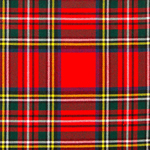Tartan Guides
Introduction
According to the Scottish Register of Tartans, a tartan is a design which is capable of being woven consisting of two or more alternating coloured stripes which combine vertically and horizontally to form a repeated checkered pattern. The pattern is known as the sett. Tartan is traditionally woven using wool, but nowadays there are many other materials that are being used in the process of making a kilt, such as poly-viscose, leather or even denim. The word tartan did not refer to the pattern or the notion of kinship initially, but rather to the type of cloth which Highlanders were wearing, in the kilt form as well.
Tartan is recognised as a symbol of the Scottish people and their culture. It's a constantly evolving part of Scottish history, as well as a worldwide known piece of fashion.
Tartan History
One of the first recorded mentions of Tartan was in 1538 when King James V purchased "three ells of Heland Tartans" for his wife to wear. And in 1587, Hector Maclean (heir of Duart) paid feu duty with sixty ells of cloth "white, black and green"- the tradition colours of the Maclean hunting tartan. An eyewitness account of the Battle of Killecrankie in 1689 describes "McDonells men in their triple stripe” but the first positive proof of the existence of what we now call ‘Tartan’, was in a German woodcut of about 1631 which is thought to show Highland soldiers - no doubt mercenaries - in the army of Gustavus Adolphus and wearing a clearly identified tartan philamhor - the great kilt.
The next important milestone in the history of tartan was the 1745 rebellion ending with the Battle of Culloden in 1746 and the following genocide in the highlands. The romantic Young Pretender, Charles Edward Stuart - Bonnie Prince Charlie - ranged his inferior Jacobite forces of Highlanders against the Duke of Cumberland's Government forces. The Jacobite army was organised into Clan regiments and as historian Jamie Scarlett explains "here we have the first hint of the use of tartan as a clan uniform." To understand how this battle proved to be the catalyst for the great Clan Tartan myth, we must look at the lifestyle and the terrain in which many of Scotland's major families or clans lived at that time.
Each area or community grouping would doubtless have, as one of its artisans, a weaver. He - they were invariably men - would no doubt produce the same tartan for those around him and that tartan would initially become what we now call a District Tartan - one worn by individuals living in close geographical proximity such as glen or strath. By its very nature, that community would be one huge extended family that soon became identified by its tartan which it wore, not to differentiate it from its neighbours in the next glen - but because that is what its community weaver produced! It was one short step from there to connect that tartan to the name of the wearers.
All weavers depended very much on local plants for their dyes so the locality of the weaver might well have some bearing on the colours of the tartan that he produced. If he lived on the west coast of Scotland, Gipsywort would give him lettuce green, seaweeds would give him flesh colour and seashore whelks might provide purple. If he lived inland, then he would undoubtedly look to the moors for his colours: heather treated in different ways would give him yellow, deep green and brownish orange; blaeberries (the favourite food of the grouse) would provide purples, browns and blues; over 20 different lichens would give him a wide range of subtle shades. If he was affluent or dyeing and weaving for a customer of some substance, then he would seek more exotic imported colours of madder, cochineal, woad and indigo.
If the concept of clan tartans was born at Culloden it wasn't universally known - in that battle, there was frequently no way of differentiating friend from foe by the tartan he wore. The only reliable method was to see with what colour ribbon - sprig – a bit of plant - each combatant had adorned his bonnet which, would differ to show the affiliation to ones Clan. This represented in Scottish Heraldry today as a ‘Plant Badge’ that would be worn by a follower to show loyalty to ones Chief. There is a contrary view that this was caused, not by the lack of clan tartans, but by the Highlander's propensity for discarding his cumbersome philamhor (belted plaid) before charging into the fray.
After Culloden and the following genocide that occurred throughout the Highlands, the Government was determined to destroy the Clan System and raised an Act of Parliament known as the “The Disarming Act” one of these laws was to make the wearing of tartan a penal offence for the next 36 years until 1782. This proscription however applied only to common Highland men - not the upper echelons of Highland society, not to Lowland Scots and not to women. But most importantly, it did not apply to the Highland regiments that were being formed in the Government army.
Tartan by Surname
To search or find a tartan by surname, clan or family, using our Tartan Finder:
1. Enter your surname (without words like “tartan” or “clan”) into our Tartan Finder
2. Once entered a list of Tartan swatches relating to that surname, clan or family will appear
3. Click on the Tartan swatch of choice
4. Select from a range of Made to Order Tartan products
5. Select again the chosen or a different Tartan
6. Select size and option (If Required)
7. Add to cart
You may also see a list of other clan or family affiliations marked as being suitable for you. This may be because your family is a Sept of another clan or related in some other historical way. If you’d like to learn more about this, see our comprehensive guide on Scottish clan names and Septs.
It’s also important to note that if you can’t find anything for your surname, you still have several options. You can try looking up grandparents’ maiden names, your spouse or partner’s name, or even just find a Tartan that you think looks nice. If you are feeling adventurous try a modern, vibrant, colourful tartan, such as Spirit of Scotland Modern or Glasgow.
The top 50 surnames in Scotland
Smith, Brown, Wilson, Thomson, Robertson, Campbell, Stewart, Anderson, MacDonald, Scott, Reid, Murray, Taylor, Clark, Mitchell, Ross, Walker, Paterson, Young, Watson, Morrison, Miller, Fraser, Davidson, Gray, McDonald, Henderson, Johnstone, Hamilton, Graham, Kerr, Simpson, Martin, Ferguson, Cameron, Duncan, Hunter, Kelly, Bell, Grant, MacKenzie, Mackay, Allan, Black, MacLeod, McLean, Russell, Gibson, Wallace and Gordon.
Many of these surnames were brought to Scotland by Anglo-Normans, whose surnames were traditionally used as given names, particularly in North America. These surnames also have a many variations, such as ancient tartan, modern tartan, weathered tartan, dress tartan and hunting tartan. The surname MacDonald, for example has over 25 variations.
Tartan vs Plaid vs Check
Today, the terms Tartan, Plaid & Check are often used interchangeably and each of these iconic patterns is in fact different. These classic patterns are some of the most widely recognised and versatile textile designs in the world. They have been popular throughout history, across cultures and continue to be staples in both fashion and interior design.
Before reading on, let's establish a commonality between these three fabric designs. Tartans, plaids and checks are all comprised of horizontal and vertical stripes. They intersect one another at 90 degree angles creating grid-like patterns.
Tartan
A pattern consisting of multiple coloured criss-crossed horizontal and vertical bands. The pattern of the stripes running vertically is duplicated EXACTLY on the horizontal axis. Where the different colours overlap, new colours are created. It is a beloved classic pattern that evokes feelings of tradition and nostalgia. In fact, the oldest known tartan fabric dates back 3,000 years!
Plaid
Traditionally, Plaid referred to a specific type of garment worn by the Scottish to protect them from cold, harsh winters. The word plaid is derived from the Gaelic word Plaide, meaning blanket. This oversized wool garment also known as a "belted plaid" or "great kilt" was worn around the waist and then draped over the left shoulder. The pattern woven into the fabric was Tartan. Scottish clans each had their own type of tartan such as, Black Watch or Royal Stewart. Often, the same clan would have two different types of tartans, one for hunting and one for dress.
Today, the term Plaid refers to patterns inspired by traditional tartan designs, and the term Tartan now refers to a type of Plaid. "Plaid" replaced "Tartan" once the patterns became popular with British and American textile manufacturers who would recreate fabrics inspired by authentic tartans. Plaids consist of crossed horizontal and vertical bands in two or more colours. The main difference between traditional tartans and other types of plaids has to do with the pattern's repeat. In regard to plaids, the pattern of the vertical stripe does not necessarily have to match the pattern of the horizontal stripe like the pattern of a tartan. Plaids have many variations of band width, repeat and/or colour.
Check
Check patterns are simpler than plaids. They generally consist of two alternating colours, but not always. Checkered patterns are symmetrical, consisting of crossed horizontal and vertical lines that form equal sized squares. Each line is intersected by the same kind of line in equal intervals and widths. There are many different types of check patterns such as Gingham, Buffalo and Windowpane.
Most Popular Tartans
Black Watch Tartan



The History
The Black Watch tartan, associated with the British infantry regiment of the same name, has a long and interesting history. Alternatively known as Grant Hunting or Government tartan, Black Watch tartan was worn first by the six “watch” companies that once patrolled the Highlands. General George Wade, with authorisation from George I, formed these six companies in 1725 following the Jacobite rebellion of 1715. The Black Watch, as they would come to be known, were employed to rid the Highlands of criminals, rebels and to deter fighting between rival clans.
The original six companies consisted of three from Clan Campbell and one from each of Clan Munro, Clan Fraser of Lovatand Clan Grant. The tartan itself was produced by over 60 weavers in the Strathspey area which was home to Clan Grant. The dark blue, black and green plaid that we know today as Black Watch is believed to have been a tartan of Clan Grant originally, hence the alternative name Grant Hunting. Given that half of the six original companies were Campbells though, the origin of the plaid may belong to this Clan. The companies of the Black Watch were later expanded to ten and then merged into a single regiment.
The uniform at that time consisted of a 12 yard plaid of tartan, a scarlet jacket and waistcoat with buff facings and a blue bonnet. The plaid was a garment fastened at the waist and draped over the shoulder which doubled as a blanket and sheltered the soldiers from the rain. Even as the 43rd regiment, they were known colloquially as the Black Watch, a name that’s origins are in dispute. One of the most popular theories is that they were named because of the dark tartan of their uniform, the Black Watch tartan we know today.
The regiment would see many changes throughout the years, however, their iconic tartan remained. The Black Watch would be on the front line beginning with the French Wars in 1745 and would feature heavily in both World Wars as would their kilts. The kilt was officially banned as combat dress in the first year of WWII as it was deemed impractical for modern warfare. It is believed that it was last widely worn during the evacuation of Dunkirk in May of 1940. In 2006 all six army regiments that existed in Scotland were merged to form the Royal Regiment of Scotland. This new regiment was given the Government tartan as their own, meaning that for at least 270 years this iconic tartan has been worn by Scottish soldiers serving all over the world.
Who Can Wear Black Watch Tartan?
Tradition has it that those who have no Tartan of their own can wear the Black Watch (The Universal or Government Tartan) or the Hunting Stewart, but not the Royal Stewart without the express authority of the Queen. However, commercialisation in recent times has rather blurred this.
Royal Stewart Tartan

History
This Tartan started life as a 'Royal' tartan - that of the Royal House of Stuart - and theoretically the personal tartan of the reigning monarch. Over the years however it became so popular and was so widely worn by all and sundry that it is now regarded as a universal Tartan. In their 1850 book 'The Clan and Family Tartans of Scotland' W and A Smith of Mauchline wrote: 'The Stuart tartan here given is that for which many years has been universally believed in Scotland to be the Tartan worn by our Scottish Sovereigns. Sometimes it is woven with a small stripe of green, bisecting the broad red belt; but we know that this green stripe is a modern innovation, and therefore we exclude it having the best authority for doing so.' The green line version is probably Stewart of Rothesay at #848 and the Vestiarium entry at #846 (original Scottish Tartans Authority references).
Theoretically this cannot be used or worn without the express permission of Her Majesty the Queen. In practice however, this is the most popular tartan ever woven and can be seen on a huge range of products. The pattern was first published by James Logan in his book, 'The Scottish Gael' in 1831, but references indicate that the sett was known at the end of the 18th century and it was reputed to have been worn by one of Bonnie Prince Charlie's followers in the 1745 rebellion. Early samples show blue as a light 'azure'. The best known of all Scottish tartans, the Royal Stewart is the tartan of the Royal House of Stewart and the personal tartan of Her Majesty the Queen. In the same way that clansmen wear the tartan of their chief, it is appropriate for all subjects of the Queen to wear the Royal Stewart tartan.
Who Can Wear Royal Stewart Tartan?
Universally recognised and now can be worn by anyone who has no clan Tartan, as detailed above.